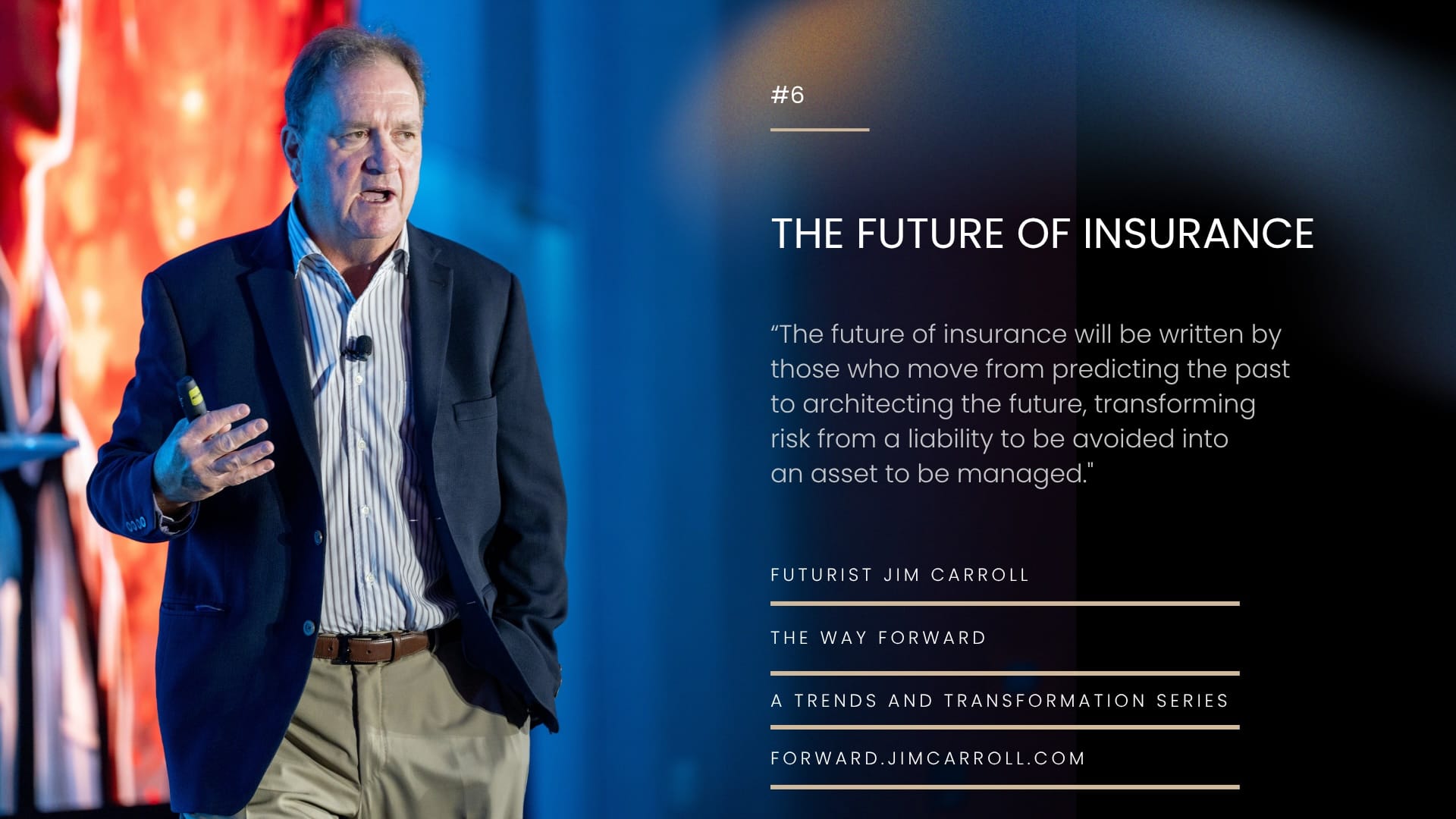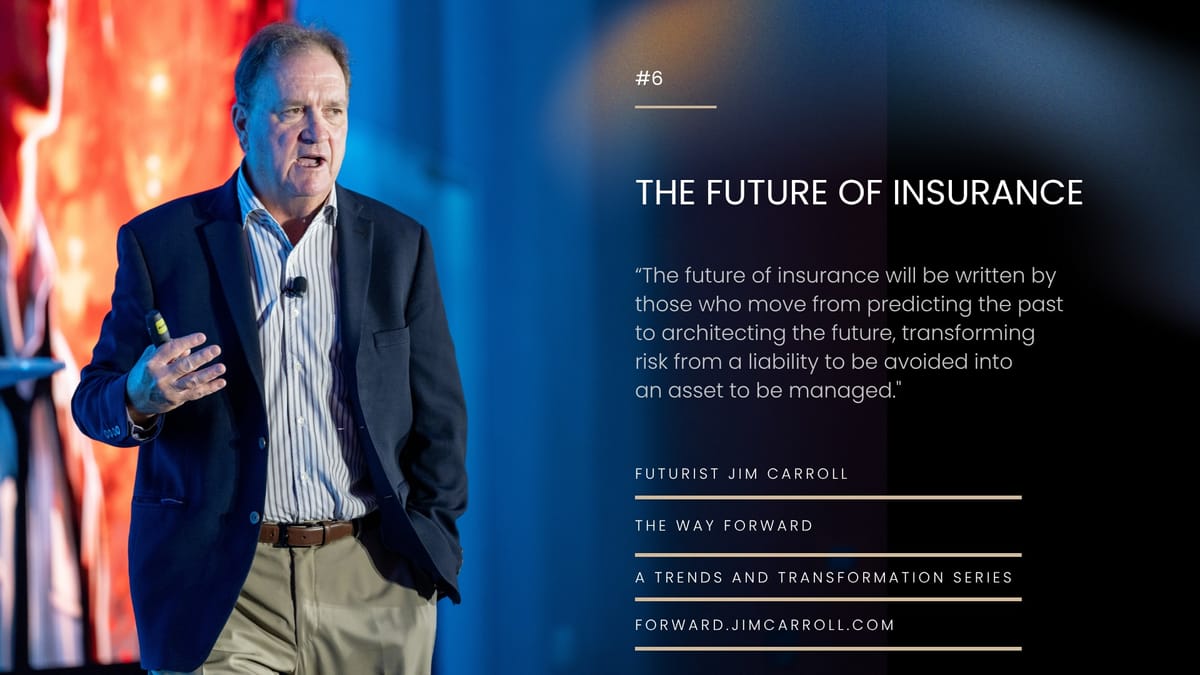“The future of insurance will be written by those who move from predicting the past to architecting the future, transforming risk from a liability to be avoided into an asset to be managed." - Futurist Jim Carroll

In 2025, the headwinds are severe, and the path forward seems shrouded in fog. We’re living through one of the most volatile and unpredictable periods in recent memory. With that being the case, I am writing this new series, The Way Forward: A Trends and Transformation Series, taking a look at the trends redefining industries, and actionable strategies organizations must pursue to align with these realities. The entire series will be found at forward.jimcarroll.com
The insurance industry stands at a historic inflection point - moving from always looking back, to increasingly looking right now and looking forward.
Think about it - for centuries, the foundation of the industry has been the actuarial analysis of the past—a model that involves looking at what happened, and indemnifying customers based on that reality. That era is over. A powerful convergence of hyper-connectivity, artificial intelligence (AI), and accelerating, complex risk is forcing a new model, in which insurance is underwritten not just by looking at the past to predict future risk, but by underwriting that risk based on real-time information and concise information on what might happen next.
This is a huge change - and one that is massive both in terms of the challenge and the opportunity.
The landscape: 10 trends redefining insurance
I've been covering trends in the industry for 30 years. Looking back at my keynotes and what I've written about the industry, 10 key trends stand out that are reshaping the global risk landscape identified above.
- The shift to predictive analytics. The industry is moving from underwriting based on historical data to real-time risk assessment based on predictive modeling.
- Hyper-connectivity & the Internet of Things (IoT). The world is becoming a network of intelligent, connected devices, providing a continuous stream of real-time data that allows insurers to move from a "repair and replace" to a "predict and prevent" model.
- The acceleration of risk. The pace of change is creating new, complex forms of risk, from cybersecurity and climate volatility to the ethical implications of AI and the "end of reality."
- AI-driven underwriting and claims. Artificial intelligence is becoming the new engine of insurance operations, used to automate underwriting, accelerate claims processing, and detect fraud with greater accuracy.
- Just-in-time" & usage-based insurance (UBI). The traditional annual policy is being disrupted by more flexible, personalized models that price risk based on actual behavior.
- The blurring of industries. The lines between insurance, technology, and other sectors are dissolving as automakers, tech giants, and data analytics firms enter the insurance space.
- The rise of the empowered, digital customer. Policyholders now expect the same level of digital convenience and personalization from their insurer that they get from Amazon or Netflix.
- The reinvention of distribution channels. The role of the traditional broker and agent is being challenged by direct-to-consumer models and new digital intermediaries.
- The transformation of actuarial science. The actuarial profession is moving beyond historical data tables to a world of real-time, predictive analytics, becoming data scientists who model complex, fast-moving risks.
- The emergence of "risk architecture" as a service. As the world becomes more complex, insurers are evolving from simply transferring risk to becoming holistic risk management partners.
A Deeper Dive: The Most Significant Forces Reshaping Insurance
Taking the trends above apart, it's pretty clear that the theoretical promise of technology in insurance has given way to irrefutable, data-backed evidence of its transformative power. A few key trends stand out for their profound and immediate impact.
From Rearview Mirror to Real-Time: The Power of Predictive Analytics & IoT
The foundational shift from a reactive to a proactive risk management model is being enabled by a torrent of real-time data from connected devices. Quite simply, as the world becomes connected, the world generates a lot of real-time information that can be analyzed for real-time risk!
This is not a niche segment but a mainstream, high-growth market. The global IoT insurance market is projected to surge from approximately $15.09 billion in 2023 to over $91.75 billion by 2030. This rapid expansion underscores the urgency for insurers to move from analyzing historical data to leveraging real-time insights for loss prevention.
The commercial auto sector is being revolutionized by Usage-Based Insurance (UBI). By leveraging telematics data (i.e., the GPS data), insurers can price risk in real time based on factors like distance traveled and driving behaviors. One study suggests that real-time driver feedback has led to a 15% reduction in accident rates in ride-sharing fleets, while aligning premiums with actual risk has achieved a claims reduction of over 20% and delivered premium savings of 30% to drivers.
The Algorithmic Underwriter: AI's Impact on Risk Selection and Pricing
Artificial intelligence is moving from the periphery to the core of insurance operations, most profoundly in the underwriting of risk.
For one top-five U.S. P&C insurer, deploying Shift Technology's AI to analyze new auto policies generated more than $15 in incremental prevented losses for every new policy analyzed, leading to a projection of more than $30 million in annual underwriting mitigation. That's a big win!
The Evolution of Business Models: InsurTech Pioneers and Incumbent Responses
Technological shifts are leading to entirely new business models, some of which are specifically aimed at less technology-adept small and medium-sized customers.
Next Insuranc operates as a direct-to-consumer digital carrier, offering tailored policies for over 1,300 types of small businesses with the ability to get a quote in under 10 minutes. In contrast, Coterie Insurance pursues a B2B2C (business to business to consumer) model, empowering agents with a simple system that allows them to generate instant, bindable quotes for their small business clients. In both cases, it's obvious there is a winning strategy in the SME space that involves making it easier for insurers to do business while potentially reaching new customers.
The Great Divide: Barriers to a Modern Insurance Industry
Despite the immense promise of these trends, the insurance industry has been notoriously slow to change. Like, really slow! It's said that more than half of the coding in the industry still runs on COBOL! This means there is a huge speed divide between the new InsurTech startups and legacy companies. This leads to:
- The legacy drag anchor: The industry's dependence on aging, monolithic core systems is a huge anchor! These systems are operationally inflexible and a significant financial drain, consuming up to 90% of the IT budget just on maintenance. Not to mention that these old systems present a major cybersecurity vulnerability.
- The human element: The industry faces a demographic time bomb, with nearly 400,000 employees expected to retire in the next few years. This is compounded by a failure to attract the next generation and a critical skills chasm in data science and AI. A lack of in-house expertise is the primary obstacle to AI adoption, and studies show that only one in three insurers has a formal AI training program in place.
- Cultural risk aversion: The very nature of insurance is to avoid risk, but this mindset becomes a major obstacle to innovation. A culture that fears failure will struggle to experiment with the new technologies and business models that are essential for future success, leading to a state of "aggressive indecision."
- The small and medium-sized carrier challenge: Smaller carriers operate with limited resources for R&D and often lack the vast troves of historical data needed to train proprietary AI models. This is creating a widening digital divide where smaller insurers are far more likely to be in the early, experimental stages of AI adoption while their larger counterparts are actively implementing proven solutions.
Beating the Odds: Case Studies in Insurance Transformation
Despite the barriers, pioneers are demonstrating that transformation is possible. Their success stories provide a powerful blueprint.
- HSB & Commercial IoT Loss Prevention: Hartford Steam Boiler (HSB) has moved beyond traditional coverage to actively mitigate losses for its commercial clients. By deploying a "virtual watchdog" system using commercial-grade IoT sensors, the company provides 24/7 monitoring of client facilities. In its first year, with over 4,000 installations, the program prevented an estimated $8 million in losses, proving that investing in prevention technology is a direct driver of profitability.
- The UBI Revolution in Commercial Fleets (Nirvana Insurance): InsurTech Nirvana Insurance uses IoT data from truck sensors to create advanced risk models for small trucking fleets. This strategy has attracted $57 million in funding, validating the model's appeal to investors and proving the value of usage-based insurance in a dynamic economy.
- The Power of Partnership (Bolttech): A prominent national insurer, constrained by fragmented legacy systems, partnered with InsurTech Bolttech to implement a unified digital distribution platform. The partnership acted as a catalyst for explosive growth, allowing the insurer to expand its network from 50 agents to over 2,000 in five years and add $4 billion in new quoted premiums.
- The Incumbent's Pivot (Liberty Mutual): Liberty Mutual executed a massive internal transformation by adopting a "serverless-first" approach using Amazon Web Services (AWS). This was not just a technology project but an operating model shift, encapsulated in their mantra: "Code is a liability." The benefits were realized in cost, speed, and agility. Application build time was slashed from an average of one year to just three months, and the cost of processing 100 million financial transactions became negligible at just $60 per million transactions.
The Playbook: 10 Actionable Strategies for Insurance Innovators
All of this means that the future of insurance will be defined by those who are bold enough to act. What do organizations need to do?
- Embrace a "predict and prevent" mindset (evolve to risk architecture): Systematically evolve your business model from selling a financial product to delivering a comprehensive risk management service. This can be achieved by developing a tiered offering that integrates IoT monitoring and risk management consulting into your policies.
- Think like a technology company: Elevate technology to a C-suite and board-level strategic priority. Adopt the philosophies of tech leaders like Liberty Mutual, re-imagining every process through a lens of customer-centric design.
- Modernize your core systems (strategically): Develop a multi-year, board-supported roadmap to migrate from monolithic legacy systems to a flexible, cloud-based, API-driven architecture. Prioritize the systems that create the biggest bottlenecks, like claims and underwriting, and consider third-party maintenance providers for stable legacy systems to free up capital for innovation.
- Harness the power of AI across the value chain. Systematically integrate AI into high-impact areas. Begin with proven, high-ROI use cases like fraud detection and claims automation to secure executive buy-in - these already have a long track record. Mandate 100% explainability for all AI models used in critical decision-making to ensure adoption and regulatory compliance.
- Innovate with new insurance products: Reinvent your products! Establish a formal process for systematically identifying, developing, and launching products that address emerging risks. Create dedicated teams from multiple departments that focus on fast-moving risk categories like advanced cybersecurity threats, climate volatility, and the unique liabilities of the gig economy.
- Build a collaborative ecosystem: Make strategic partnerships with tech companies in the industry (aka InsurTechs) as a primary pillar of your corporate innovation strategy. Identify specific gaps in your systems and seek out a best-in-class partner to fill that gap.
- Future-proof your workforce (the #1 priority): Declare a "war for talent" and launch a multi-pronged strategy to build the workforce of the future. Invest heavily in upskilling existing employees with formal certifications in data science and AI. Fundamentally change your recruitment approach to hire top technology professionals and teach them insurance.
- Adopt an "upside-down innovation" model: Formally empower frontline staff, agents, and brokers to be a primary source of innovation. Create methods for them to submit ideas that go beyond the 'suggestion box', so they can report inefficiencies, highlight unmet customer needs, and ground innovation in solving real-world problems.
- Build a culture of bold experimentation: De-risk innovation by creating a "safe to fail" environment. Allocate a specific, protected portion of the annual budget for experimental projects. When an experiment fails, publicly celebrate the "intelligent failure" and disseminate the lessons learned across the organization.
- Empower the independent agent with better tech!: Fundamentally re-evaluate and reinvent your value proposition for the independent agent channel. Transform your role from a simple product provider to a true business partner by equipping agents with a modern digital marketing toolkit, including training and resources for SEO, content marketing, and social media engagement.
The insurance industry is at a historic inflection point. The forces of digitization, hyper-connectivity, and artificial intelligence are not just incremental improvements; they are the agents of a fundamental reinvention of the concept of risk.
The leaders who thrive will be those who move beyond the models of the past and embrace a new identity as technology-driven risk architects.
The future of insurance will not be built with the actuarial tables of yesterday.
It will be underwritten with real-time data, managed with intelligent algorithms, and delivered through seamless digital platforms, guided by a new generation of leaders who are not afraid to build a bolder, faster, and smarter future.
Like I said.
That's a big challenge.
And it's a huge opportunity!
Futurist Jim Carroll has covered the insurance industry extensively in his blog, which can be found at https://jimcarroll.com/category/insurance/

